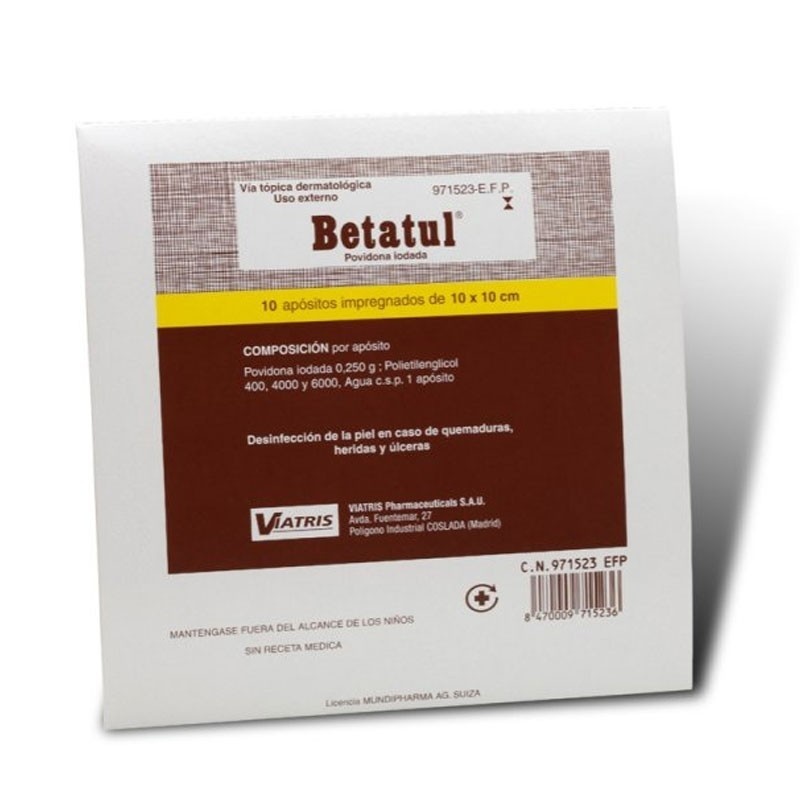

БЕТАТУЛ 250 МГ ПРОПИТАННАЯ ПОВЯЗКА

Спросите врача о рецепте на БЕТАТУЛ 250 МГ ПРОПИТАННАЯ ПОВЯЗКА

Инструкция по применению БЕТАТУЛ 250 МГ ПРОПИТАННАЯ ПОВЯЗКА
Введение
Инструкция: информация для пользователя
Бетатул 250 мг пропитанный пластырь
Йодоповидон
Прочитайте внимательно всю инструкцию перед началом использования этого лекарства, поскольку она содержит важную информацию для вас.
Следуйте точно инструкциям по применению лекарства, изложенным в этой инструкции или указанным вашим врачом, фармацевтом или медсестрой.
- Сохраните эту инструкцию, поскольку вам может потребоваться прочитать ее снова.
- Если вам нужен совет или дополнительная информация, обратитесь к вашему фармацевту.
- Если вы испытываете побочные эффекты, обратитесь к вашему врачу, фармацевту или медсестре, даже если это побочные эффекты, не указанные в этой инструкции. См. раздел 4.
- Вам следует обратиться к врачу, если ваше состояние ухудшается или не улучшается.
Содержание инструкции
- Что такое Бетатул и для чего он используется
- Что вам нужно знать перед началом использования Бетатула
- Как использовать Бетатул
- Возможные побочные эффекты
- Хранение Бетатула
- Содержание упаковки и дополнительная информация
1. Что такое Бетатул и для чего он используется
Йодоповидон, активное вещество этого лекарства, является антисептиком (уничтожающим микробы, вызывающие инфекции), содержащим йод.
Бетатул показан как антисептик для кожи общего использования, для небольших ран и поверхностных порезов, легких ожогов, потертостей.
2. Что вам нужно знать перед началом использования Бетатула
Не используйте Бетатул
- Если вы аллергичны к йодоповидону или любому другому компоненту этого лекарства (перечисленному в разделе 6).
- Если у вас гипертиреоз или другие острые заболевания щитовидной железы.
- До, во время и после применения радиоактивного йода.
- С продуктами, содержащими ртуть, из-за образования вещества, которое может повредить кожу.
- У детей младше 1 года.
Предостережения и меры предосторожности
Обратитесь к вашему врачу, фармацевту или медсестре перед началом использования Бетатула.
Наружное применение. Не принимать внутрь. Избегайте контакта с глазами, ушами и другими слизистыми оболочками. Обратитесь к вашему врачу, если симптомы сохраняются или ухудшаются.
Пациенты с зобом, узлами в щитовидной железе или другими неострыми заболеваниями щитовидной железы подвержены риску развития гипертиреоза при применении высоких доз йода. У этих пациентов не следует применять Бетатул в течение длительного времени и на обширных участках кожи, если это не строго необходимо. Даже после окончания лечения следует быть внимательным к ранним симптомам возможного гипертиреоза и, если необходимо, контролировать функцию щитовидной железы.
Не следует использовать до или после сцинтиграфии с радиоактивным йодом или лечения рака щитовидной железы радиоактивным йодом.
Следует проводить тесты на функцию щитовидной железы при длительном применении.
Дети
Новорожденные и маленькие дети подвержены большему риску развития гипотиреоза. Если Бетатул используется у детей, важно контролировать функцию щитовидной железы.
Не рекомендуется использовать у детей младше 1 года.
Применение Бетатула с другими лекарствами
Сообщите вашему врачу или фармацевту, если вы используете, недавно использовали или можете использовать любое другое лекарство.
Не использовать с ртутьсодержащими препаратами, серебром, перекисью водорода или тауролидином (антисептиками).
Следует избегать длительного применения у пациентов, проходящих одновременную терапию литием (используемым в психиатрии).
При одновременном или последующем применении антисептиков с октенидином может появиться временная темная окраска пораженных участков.
Взаимодействие с диагностическими тестами: применение йодоповидона может привести к ошибкам в тестах с толвидином или гваяколом для определения гемоглобина или глюкозы в кале или моче. Также может влиять на тесты на функцию щитовидной железы и лечение радиоактивным йодом.
Сообщите вашему врачу, когда вам необходимо пройти любой диагностический тест.
Сообщите вашему врачу, если:
- Симптомы не улучшаются или ухудшаются
- Вы получали лечение радиоактивным йодом в течение последних 4 недель.
- У вас есть аллергия или раздражение кожи, такое как покраснение, небольшие пузырьки, зуд или сыпь, которые могут появиться сразу.
Беременность, лактация и фертильность
Если вы беременны или в период лактации, считаете, что можете быть беременной или планируете стать беременной, обратитесь к вашему врачу или фармацевту перед использованием этого лекарства.
Использовать только если это строго необходимо, применение должно быть минимальным. Избегайте длительного применения.
Применение может привести к временному гипотиреозу у плода и новорожденных. Может быть необходимо контролировать функцию щитовидной железы у детей.
Вам следует проконсультироваться с врачом о применении у детей в возрасте от 1 до 2 лет.
Вождение и использование машин
Бетатул не влияет на способность управлять транспортными средствами или использовать машины.
3. Как использовать Бетатул
Следуйте точно инструкциям по применению лекарства, изложенным в этой инструкции или указанным вашим врачом, фармацевтом или медсестрой. В случае сомнений обратитесь к вашему врачу, фармацевту или медсестре.
Наружное применение. После мытья и высушивания нанесите непосредственно на пораженный участок. Накройте марлей или ватой. Закрепите бинтом.
Меняйте ежедневно или каждые 2 дня.
Если вы применили больше Бетатула, чем необходимо
В случае применения чрезмерной дозы продукта и появления раздражения кожи, необходимо промыть пораженный участок большим количеством воды, прекратить лечение и, если раздражение сохраняется, обратиться к врачу.
Симптомы могут включать боли в животе, анурию (отсутствие или уменьшение мочи), проблемы с кровообращением, дыханием и метаболизмом. Чрезмерное количество йода может привести к зобу, гипотиреозу и гипертиреозу.
В случае случайного проглатывания обратитесь в медицинское учреждение или позвоните в Службу токсикологической информации, телефон: 91 562 04 20, указав название препарата и количество, принятое внутрь.
Если у вас есть какие-либо другие вопросы о применении этого лекарства, обратитесь к вашему врачу, фармацевту или медсестре.
4. Возможные побочные эффекты
Как и все лекарства, это лекарство может вызывать побочные эффекты, хотя не все люди испытывают их.
В редких случаях, когда появляется раздражение кожи или аллергия, необходимо прекратить лечение и промыть пораженный участок водой.
Редкие побочные эффекты (могут возникать у 1-10 человек из 10 000) включают гиперчувствительность и контактный дерматит, проявляющийся покраснением кожи, небольшими пузырьками и зудом.
Очень редко (могут возникать у менее 1 человека из 10 000) были зарегистрированы анафилактические реакции (тяжелая аллергическая реакция), гипертиреоз с тахикардией и агитацией, а также ангioneurotic отек (отек, вызванный аллергией).
Другие побочные эффекты неизвестной частоты включают гипотиреоз, электролитный дисбаланс, метаболическую ацидоз, острую почечную недостаточность, аномальную осмолярность крови, эксфолиативный дерматит, сухость кожи, изменение цвета кожи и химический ожог кожи.
Если вы считаете, что любой из побочных эффектов, которые вы испытываете, является серьезным, или если вы заметили любой побочный эффект, не указанный в этой инструкции, сообщите вашему врачу или фармацевту.
Сообщение о побочных эффектах
Если вы испытываете любой побочный эффект, обратитесь к вашему врачу, фармацевту или медсестре, даже если это возможные побочные эффекты, не указанные в этой инструкции. Также вы можете сообщить об этом напрямую через Систему фармаковигиланса лекарственных средств для человека (https://www.notificaram.es). Сообщая о побочных эффектах, вы можете внести свой вклад в предоставление более полной информации о безопасности этого лекарства.
5. Хранение Бетатула
Храните это лекарство в недоступном для детей месте.
Храните при температуре ниже 30°C в оригинальной упаковке, защищая от света и влаги.
Не используйте это лекарство после истечения срока годности, указанного на упаковке после CAD или EXP. Срок годности - последний день месяца, указанного.
Лекарства не должны выбрасываться в канализацию или мусор. Отнесите упаковку и лекарства, которые вам больше не нужны, в пункт SIGRE аптеки. Если у вас есть сомнения, обратитесь к вашему фармацевту, как избавиться от упаковки и лекарств, которые вам больше не нужны. Таким образом, вы поможете защитить окружающую среду.
6. Содержание упаковки и дополнительная информация
Состав Бетатула
Активное вещество - йодоповидон. Каждый пропитанный гель-пластырь размером 10 х 10 см содержит 250 мг йодоповидона. Другие компоненты (вспомогательные вещества) - полietilengликоль 400, полietilengликоль 4000, полietilengликоль 6000, очищенная вода и гидрофильная марля.
Внешний вид продукта и содержание упаковки
Упаковка, содержащая 10 пакетов из полипропилена с 1 пропитанным пластырем каждый.
Владелец разрешения на маркетинг иответственный за производство
Владелец разрешения на маркетинг
Cooper Consumer Health B.V.
Verrijn Stuartweg 60,
1112 AX Diemen,
Нидерланды
Ответственный за производство
MEDA Manufacturing, Бордо
Av. Pdt. J. F. Kennedy. BP 100
Merignac – Cedex
Ф-33700
Франция
Вы можете запросить дополнительную информацию о этом лекарстве, обратившись к местному представителю владельца разрешения на маркетинг:
Vemedia Pharma Hispania, S.A.
C/ Aragón, 182, 5-я пл.
08011 Барселона
Испания
Дата последней ревизии этой инструкции:август 2022
Подробная и актуальная информация о этом лекарстве доступна на сайте Агентства по лекарственным средствам и медицинским изделиям Испании (AEMPS) https://www.aemps.gob.es/
- Страна регистрации
- Активное вещество
- Требуется рецептНет
- Производитель
- Информация носит справочный характер и не является медицинской рекомендацией. Перед приемом любых препаратов проконсультируйтесь с врачом. Oladoctor не несет ответственности за медицинские решения, принятые на основе этого контента.
- Аналоги БЕТАТУЛ 250 МГ ПРОПИТАННАЯ ПОВЯЗКАФорма выпуска: ПЕРЕВЯЗОЧНЫЙ МАТЕРИАЛ, 0,350 гАктивное вещество: Повидон-йодПроизводитель: Cooper Consumer Health B.V.Не требуется рецептПроизводитель: Alfasigma Espana S.L.Не требуется рецепт
Врачи онлайн по БЕТАТУЛ 250 МГ ПРОПИТАННАЯ ПОВЯЗКА
Консультация по дозировке, побочным эффектам, взаимодействиям, противопоказаниям и продлению рецепта на БЕТАТУЛ 250 МГ ПРОПИТАННАЯ ПОВЯЗКА – по решению врача и с учетом местных правил.







